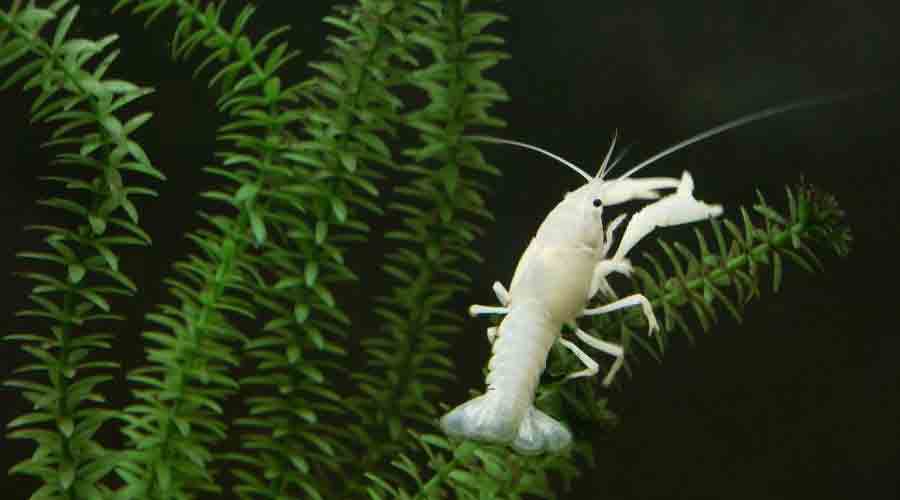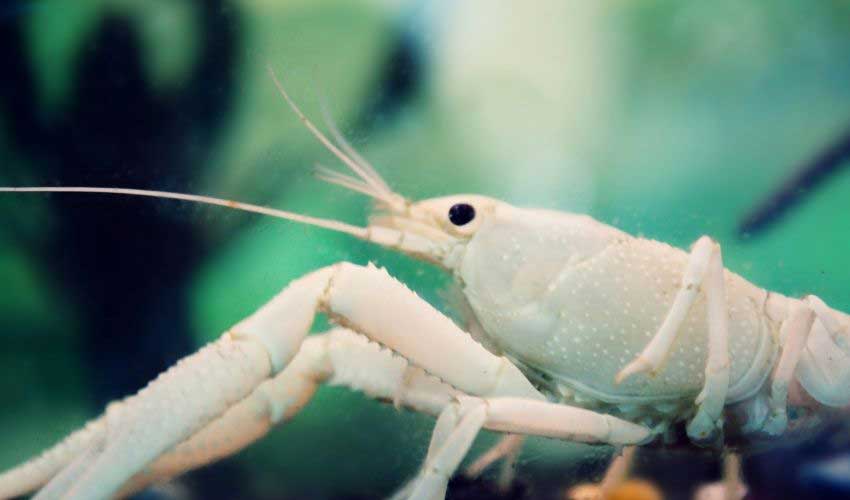In this blog, we are going to talk about the white crayfish (Procambarus Clarkii). A crayfish that’s also known as the white specter crayfish, vanilla lobster, and vanilla crawfish.
Quick Info About the White Specter Crayfish
| Species: | Procambarus Clarkii |
|---|---|
| Native to: | Southeaster parts of the United States (Florida) |
| Temperament: | Aggressive |
| Minimum Tank Size: | 20 gallons |
| Eating: | Omnivores, can be fed sinking algae pellets, vegetables, bloodworms, and brine shrimp. |
| Care Level: | Beginner |
| Tank Mates: | Tetras Hatchet Fish Rainbow Shark Red-Tail Sharks Rosy Red Minnows Rainbow Darters |
| Interesting Facts: | Can regenerate limbs. |
Origin of the White Crayfish
The white crayfish or white specter crayfish is a variation of the blue crayfish. So it is also a member of the Procambarus Clarkii species.
When comparing the white specter crayfish and the blue crayfish, many people might assume that there’s no way the two could be related. There’s quite a profound difference obviously as one is an electrifying blue color, while the other is a pale white color. But still, both are very beautiful and unique.
The white crayfish and the blue crayfish are both native to the Southeastern parts of the United States. They live in rivers, lakes, streams, and ponds in Florida, all the way down to the Keys.

The Temperament of White Crayfish
I’ve owned several crayfish over the years. And, one of the crayfish I owned was a white specter.
I kept a blue crayfish and a white crayfish together. This was when I was first getting into the crayfish-keeping hobby. Not only did I keep the two together, but I kept them in a tank that was too small (more on tank size later).
My blue cray and my white cray were both about the same size, but one thing I noticed about the white lobster was its aggression. It eventually killed and ate the other blue crayfish. We’ll say that was a learning moment for me.
Now, I’m not saying that white crayfish are any more aggressive than any other crayfish, which are very aggressive. That was just my experience with my one and only vanilla lobster.
In short, all crayfish are aggressive. These guys are very territorial and will chase your other fish, crayfish, and fight anything they possibly can. They’ll also eat your other fish if given the chance. But, I’ll talk more later about the types of fish that can be kept with crayfish. Because it is very doable.
Now, just as a note, some of the smaller crayfish like the Mexican dwarf crayfish are not aggressive like others. Mexican dwarf crayfish, for example, actually do pretty well in community fish tanks with other peaceful fish.
Interesting Facts:
Here are a few cool facts about the white cray:
- Like to burrow and hide
- Will eat their exoskeleton after molting
- Can live for around five years give or take
- Has gills and can live out of water for long periods if gills are kept moist
- Like all crayfish, is an escape artist
Caring for White Specter Crayfish
Caring for the vanilla lobster isn’t really too difficult. Most of the “hard” work is done on the frontend when you set up your tank. Other than that, keeping crayfish is pretty low maintenance and is at the same time an enjoyable hobby.
Let’s take a closer look at white crayfish care.
Tank Size
When it comes to tank size, you want to keep your crayfish in nothing smaller than a 20-gallon fish tank. And, I’ll tell you why.
Even though you could get away with a smaller tank like a 10-gallon fish tank, it’s better to go bigger. For one, crayfish are dirty and put out a lot of waste. So it’s easier to keep a bigger tank clean than it is to keep a smaller tank clean.
Also, a 20-gallon fish tank will allow you to have enough room for at least a few other fish. Personally, I just think a 10-gallon is still cutting it close if you are going to keep other fish. That’s based on my experience.
Remember, it’s always a good idea to plan your tank ahead of time. But, worst-case scenario, you can always upgrade the size of your tank at a later date.
If you plan on going big from the start, check out these fish tanks of 100 gallons plus. They are the crème de la crème of fish tanks.
Substrate
For the bed of your tank, you can use either sand or small pebbles. Crayfish love to burrow, so sometimes you might even see them arranging your pebbles into an area where they can burrow and hide. I use small black gravel in my crayfish tank. It can really make the colors of your blue or white crayfish pop.
Water Requirements
After you have placed the substrate in your tank, hideouts (we’ll get to this further down), and other decorations, then you can place your conditioned water into the tank. Conditioning the water is a simple process that uses a “water conditioner” to remove chlorine from water and make it safer for aquatic life.
After you add the water comes the tricky part, cycling the tank.
Before you add any crayfish or freshwater fish to a fish tank, you have to cycle the tank. Cycling the tank is essential for setting up a biofilter that contains healthy bacteria. These bacteria neutralize toxins in the tank that come from your fish and crayfish eating and pooping.
For more information on cycling the water in your fish tank, I highly recommend reading the blog, “How Do You Set Up a Crayfish Tank?”
Water Parameters
- Keep the tank water between 70 to 75 degrees
- Shoot for a pH of about 7
Maintaining the Aquarium
After your tank is cycled, and you have placed your fish and crayfish into the tank, there will still be required maintenance to keep the tank’s environment healthy and clean. All you will need to do is to change roughly 15 to 20% of the tank’s water every two weeks or so. If you notice the tank getting nasty before two weeks, you may want to do your water changes earlier.
Additionally, you’ll probably want to change the filter cartridge in your tank about once every two to four weeks as well. Factors like other aquatic life, feeding habits, and tank placement can affect how quickly your tank gets dirty.
Tips for Keeping Your Tank Healthy
Other than water changes, and changing the filter cartridge, there are other things you should do to keep your tank clean. Take a look:
- Do not place your aquarium in the direct line of the sunlight. This can lead to an overgrowth of algae.
- Don’t keep too many fish in the tank. Follow the rule of one inch of fish per gallon of water.
- Don’t overfeed your fish or crayfish. This too can lead to the overgrowth of algae.
Feeding White Specter Crayfish
Crayfish are omnivores. They will eat pretty much anything. For example, as I mentioned earlier, even other crayfish.
In the wild, you can find white crayfish eating worms, plant matter, and fish that are both alive and dead. These guys are not picky at all.
In captivity, crayfish may still eat a fish every now and then if they can catch one, but you can feed them other things.
For pet crayfish, you can feed them bloodworms, brine shrimp, frozen veggies (peas, carrots), and sinking algae pellets.
Food for Pet Crayfish:
- Frozen vegetables (peas, carrots, cucumber)
- Sinking algae pellets
- Brine shrimp
- Bloodworms
Tank Mates for Vanilla Crayfish
Here is where it can get dangerous if you aren’t careful. Yes, you can keep other fish with your white crayfish, but, you don’t want to choose fish that swim on the bottom of the tank, are slow-moving, and just too nice. So plecos, snails, and other similar types of aquatic life should not be kept with the white crayfish.
If you plan on keeping other fish in your tank, just like with other crayfish, you’ll want to get fish that swim in the middle to top of the tank and have no problem holding their own.
Here are a few of the fish I have kept with my crayfish over the years.
Fish That Work with Crayfish
- Hatchet fish
- Danios
- Rosy red minnows
- Rainbow darters
- Neon tetras
Hideouts
Crayfish like to burrow and hide. I mean, you will see them running all over the tank, climbing on ornaments, and having fun, but, these guys need a place to hide. Not only is burrowing and hiding out something they like to do, but it’s necessary when they molt.
Plants and Crayfish
Like I said earlier, crayfish are aggressive and they are omnivores. So, this means they will eat everything. When it comes to plants in your fish tank, I’d recommend fake plants with your pet crayfish unless you don’t mind them destroying or eating your real plants.
Molting
If you notice that your crayfish seems a bit lazy, is not eating, or is hiding out a lot, he may be about to molt. This is perfectly normal and healthy.
When crayfish molt, they become weaker and can be easy targets for more aggressive fish. For this reason, providing your white crayfish with a simple little hideout, or even PVC pipe is a good idea. It will give them a place to recover after molting.
Crayfish will molt up to 10 times in their first year, but as they grow older, the number of molts per year will significantly decrease.
Pro tip: After your crayfish molts, leave the exoskeleton. Your crayfish will eat it to strengthen its new exoskeleton.
Breeding
Okay, step one in breeding crayfish is pretty simple. Get a male and at least one other female crayfish. Also, you are going to need a decent-sized tank. And, I highly suggest having a totally separate tank for the babies. Make sure both tanks have lots of hideouts.
After the male and female cray does their business, you’ll eventually see eggs on the underbelly of the female. In about a week’s time, you will notice baby crays hatched and on the swimmerets of the female.
From here, you’ll want to carefully pick up the female with the babies, and move her to the smaller tank. Gently remove the babies into the tank, and then place the mother back into the main tank.
In the tank with babies, make sure you have a sponge filter.
You will need to feed the babies often. And just be ready, many of the babies will die or be eaten. It’s totally normal.
White Specter Crayfish: A Recap
So in this blog, we took a close look at the white crayfish – a crayfish from the Southeastern Part of the United States that is a variation of the blue crayfish.
Keeping crayfish is relatively easy, but you want to be sure you set up the tank correctly and use at least a 20-gallon fish tank. Be sure to condition and cycle the water before adding your crayfish. Also, be sure to maintain your tank with regular water changes.
Also, you want to be careful with what types of other fish you keep with your vanilla lobster. Select fish that can hold their own and swim in the middle to the top of the tank.
Take a Look

